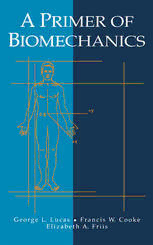
A Primer of Biomechanics PDF
Preview A Primer of Biomechanics
A Primer of Biomechanics Springer Science+Business Media, LLC George L. Lucas, M.D. Francis W. Cooke, Ph.D. Elizabeth A. Friis, Ph.D. A Primer of 8iomechanics Illustrations by Danielle Y. Chinn With 146 Illustrations Springer George L. Lucas, M.D. Elizabeth A. Friis, Ph.D. Professor and Chainnan, Department of Research Scientist, Orthopaedic Research Surgery, Division of Orthopaedic Institute, Inc., Via Christi Regional Surgery, University of Kansas School Medical Center-St. Francis Campus of Medicine, Wichita, KS 67214, USA Research Instructor, Department of Surgery, Division of Orthopaedic Francis W. Cooke, Ph.D. Surgery, University of Kansas School Research Director, Orthopaedic of Medicine, Wichita, KS 67214, Research Institute, Inc., Via Christi USA Regional Medical Center-St. Francis Campus Daoielle Y. Chioo Research Professor, Department of Graphic Designer/lllustrator, dc design Surgery, Division of Orthopaedic Surgery, University of Kansas School of Medicine, Wichita, KS 67214, USA Library of Coogress Cataloging-in-Publication Data Lucas, George L. A primer of biomechanics / George L. Lucas, Francis W. Cooke, Elizabeth A. Friis. p. cm. Includes bibliographical references and index. ISBN 978-0-387-98456-8 ISBN 978-1-4419-8487-6 (eBook) DOI 10.1007/978-1-4419-8487-6 1. Human mechanics. 2. Orthopedics. 1. Cooke, Francis W. II. Friis, Elizabeth. III. Title. QP303.L83 1998 612.7'6-dc21 97-48865 Printed on acid-free paper. © 1999 Springer Science+Business Media New York Originally published by Springer-Verlag New York, Inc.in 1999 AlI rights reserved. This work may not be translated or copied in whole or in part with out the written permission of the publisher (Springer Science+Business Media, LLC), except for brief excerpts in connection with reviews or scholarly analysis. Use in connec tion with any form of infonnation storage and retrieval, electronic adaptation, comput er software, or by similar or dissimilar methodology now known or hereafter developed is forbidden. The use of general descriptive names, trade names, trademarks, etc., in this publication, even if the former are not especially identified, is not to be taken as a sign that such names, as understood by the Trade Marks and Merchandise Marks Act, may accordingly be used freely by anyone. While the advice and information in this book are believed to be true and accurate at the date of going to press, neither the authors nor the editors nor the publisher can accept any legal responsibility for any errors or omissions that may be made. The publisher makes no warranty, express or implied, with respect to the material contained herein. Production coordinated by Impressions Book and Joumal Services, Inc., and managed by Terry Komak; manufacturing supervised by Thomas King. Typeset by Impressions Book and Joumal Services, Inc., Madison, WI. 987 6 5 432 1 ISBN 978-0-387-98456-8 SPIN 10659576 This book is dedicated to the residents in orthopaedic surgery-past,present, andfuture-who have studied our syllabus on biomechanics, worked through the demonstra tionproblems, and worked with us inthe laboratory. Preface Asubstantial knowledge ofbiomechanics andbiomaterials isessential fortoday'sorthopaedicsurgeon.Unfortunately,mostofusdonotcome from an engineering background, and much of the writing about bio mechanics is difficult for us to understand. This is particularly true whenamathematicalformula isutilized because,even ifonehastaken calculus incollege, such skills are quickly forgotten if not used regu larly.Afew simple formulas areessential forclarity,andremembering afew basic ones can come in handy when taking the Orthopaedic In Training Examination or perhaps Part Iof the American Board of Or thopaedic Surgery Examination, but none of the formulas in this book require anything beyond a rudimentary recolIection of basic algebra. Inaneffort to understand how andwhy apatient'sbone broke,how torepair such afracture,orwhy acertain repair technique did notsuc ceed, orthopaedic surgeons constantly employ a knowledge of and appreciation formechanics, forces, forcedimensions,velocity,andnu merous other concepts related to biomechanics.Thus we need to un derstand asclearly as possible, without resorting to complex analyses ormathematicalcalculations,asmuchabout biomechanicsasispracti cal.This book provides fundamental knowledge about the subject ina highly readable andunderstandablefashion. Wehave attempted tode mystify the subject of biomechanics while providing the student, or thopaedic resident, oreven practicing orthopaedistwithbasicconcepts thatwilIheighten their understandingofclinical situations.Oneofour basic techniques of teaching orthopaedics is toencourageresidents to relate what they have read intexts orjournals to specificpatients they have seen.Reaching back into one's mind to recalI how a similar pa tientwastreated ismuchmoreeffective thantryingtoremembersome- vii viii Preface thing read out of context in a textbook on fractures, for example. By providingbrief,clinical vignettestointroducevarious subtopicsofbio mechanics, reader interest and focus is, in our view, significantly en hanced.Wehope that readerswill findthis approach arefreshing way to come to grips with what is sometimes considered a "dry" subject. GEORGEL.LUCAS, M.D. FRANCISW.COOKE, PH.D. ELIZABETH A.FRIIS, PH.D. Acknowledgments Thisbook,likeallothers,hasbeenbothalaborofloveandatestofour will.Also,likeallother books, thiswork isnotexclusivelytheproduct oftheauthors, andweacknowledgetheassistance andsupportofmany others.Weareespecially grateful tothefollowing persons: Our families for their patient understanding and forbearance during this period Dustan Hahn,former research assistant intheOrthopaedic Research Institute, withwhom theideawas firstdiscussed Juanita RidgewayandRita Baker,our secretaries, forhelp with sec retarial details The hospital volunteers who helped with proofreading,typing, and photocopying Via Christi Regional Medical Center (St. Francis) for facility and personnel support Charles Graberfor assistance inthelaboratory Christoph Roth and Gunther Becht for assistance with generating figuresforand editing ofChapter 11 James Carr,MD, DanGurley,MD, Craig Hansen, MD,ToddSwen ning, MD, and Lance Snyder, MD (orthopaedic residents) for their careful review ofthedeveloping manuscript andtheir helpful sug gestions John Osland, MD, forhis work incritiquing Chapter 7 DavidA.McQueen,MD,forhis work incritiquing Chapter 11 ix x Acknowledgments Danielle Chinn,whose name appropriatelyappears onthetitlepage, forhersuperb illustrations,whichweredone undersignificanttime constraints Esther Gumpert, Anna Fossella, and Josh Paul of Springer-Verlag, New York,for their patience, understanding,assistance, and faith. G.L.L. EW.e. E.A.E Contents Preface vii Acknowledgments ix Mechanics 1 QI: Clinical Question:DistractionForceinTraction 1 1.1 Mechanics 2 1.2 Newton'sLaws 4 1.3 Characteristics ofForces 5 1.3.1 Magnitude 5 1.3.2 Direction 5 1.3.3 Vectors 6 1.3.4 Point ofApplication 6 1.3.5 Effect 7 1.4 Coordinate Systems 7 1.5 ResolutionofaForce intoItsComponents 9 1.6 TrigonometricAnalysis ofForce Systems 11 1.7 Addition ofForceVectors 12 1.8 StaticEquilibrium 14 1.8.1 TwoForces 14 1.8.2 Multiple Forces 14 1.8.3 DeterminationofUnknown Forces 16 AI: ClinicalAnswer 22 2 Moments 23 Q2: ClinicalQuestion:ForcesattheElbowJoint 23 2.1 Moments 24 2.1.1 Moments asVectors 25 2.1.2 Couples 26 xi
